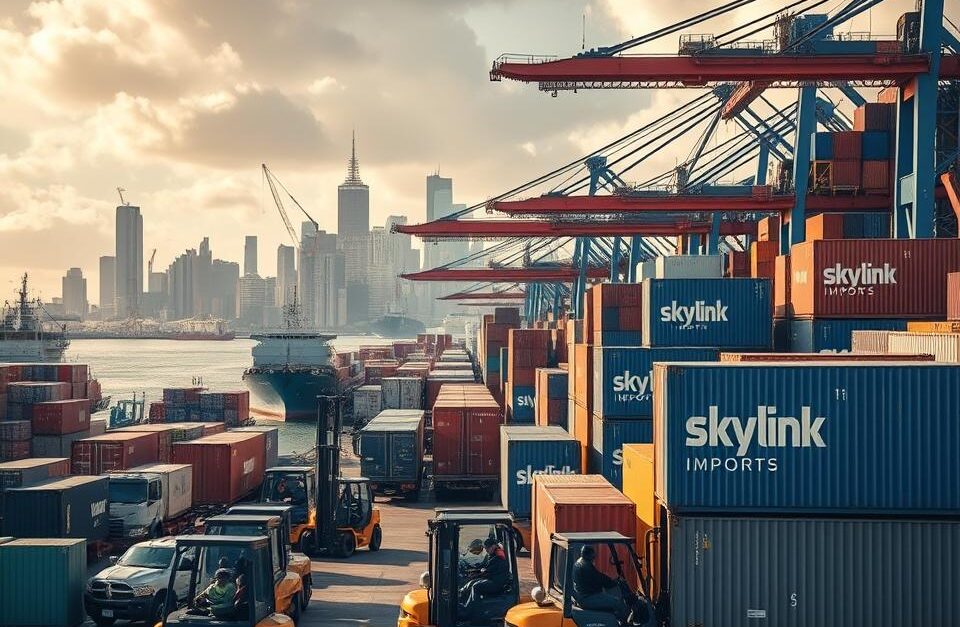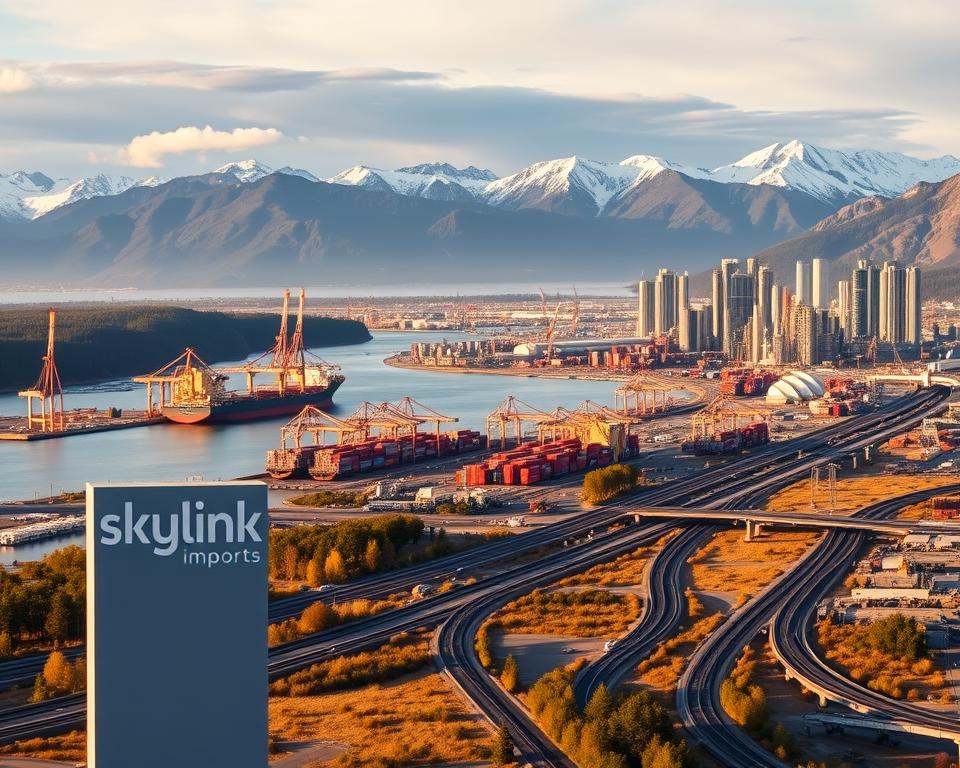
Canada’s import market is a significant contributor to the country’s economy, with over $400 billion worth of goods imported annually. This presents a substantial opportunity for businesses looking to capitalize on the demand for international products.
With Skylink Imports as your trusted partner, you can navigate Canada’s complex trade landscape with ease. Our commitment to efficiency, reliability, and transparency ensures that your importing process is streamlined and profitable.
To maximize profits, it’s essential to understand the regulations, requirements, and strategies involved in importing goods into Canada. In this comprehensive guide, we will walk you through the process, providing valuable insights and practical tips to help you succeed.
Key Takeaways
- Understanding Canada’s import regulations and requirements
- Strategies for maximizing profits when importing goods
- The importance of partnering with a trusted import-export solutions provider
- Navigating Canada’s complex trade landscape
- Streamlining your importing process for efficiency and profitability
Understanding Canada’s International Trade Landscape
With over $1.2 trillion in annual trade, Canada stands as one of the world’s largest trading nations. This significant trade volume underscores Canada’s critical role in the global economy and highlights the country’s diverse trade activities.
Canada’s $1.2 Trillion Annual Trade Volume
Canada’s annual trade volume is a testament to its strong economic position. The country’s trade activities are driven by a combination of factors, including its strategic geographical location, diverse economy, and favorable trade agreements.
Key statistics that illustrate Canada’s trade prowess include:
- A total trade volume of over $1.2 trillion annually
- Significant trade relationships with major economies like the United States, China, and the European Union
- A diverse range of traded goods, including energy resources, agricultural products, and manufactured goods
Key Trade Agreements and Partners
Canada’s trade landscape is shaped by several key trade agreements that facilitate its international trade activities. Some of the most significant agreements include:
| Trade Agreement | Partners | Key Benefits |
|---|---|---|
| United States-Mexico-Canada Agreement (USMCA) | USA, Mexico | Modernized trade rules, increased access to North American markets |
| Comprehensive Economic and Trade Agreement (CETA) | European Union | Reduced tariffs, increased access to EU markets |
| Canada-India Foreign Investment Promotion and Protection Agreement (FIPA) | India | Promotes bilateral investment, protects investors’ rights |
High-Demand Import Categories
Certain import categories are in high demand in Canada, driven by consumer needs, technological advancements, and economic activities. Some of these categories include:
“The demand for technology products, such as electronics and telecommunications equipment, continues to grow in Canada, driven by consumer demand and technological innovation.”
Other high-demand categories include:
- Energy and natural resources
- Agricultural products and food items
- Automotive parts and accessories

Essential Requirements for Importing into Canada
To successfully import goods into Canada, businesses must comply with several essential requirements. Understanding these requirements is crucial for navigating the complex landscape of international trade.
Business Registration and Import Licenses
Before importing goods into Canada, businesses must register their company and obtain necessary licenses. This involves registering for a Business Number with the Canada Revenue Agency (CRA). Certain goods may require additional licenses or permits, such as those related to agricultural products or controlled substances.
As noted by the Canada Border Services Agency (CBSA), “Importers must ensure they have the necessary licenses and permits before importing goods into Canada.” This emphasizes the importance of thorough preparation.
Business Number and Import-Export Account
A Business Number is essential for interacting with government departments and agencies. Additionally, businesses may need to open an Import-Export Account to report imports and exports.

Documentation Requirements
Accurate documentation is critical for importing into Canada. Key documents include the Commercial Invoice, Canada Customs Coding Form (B3), and any relevant certificates or licenses. Ensuring that these documents are complete and accurate can help prevent delays or penalties.
Skylink Imports provides top-notch import-export solutions, making them an ideal partner for businesses looking to import goods into Canada. With their expertise, businesses can navigate the complex requirements and ensure compliance with Canadian regulations.
“Understanding and complying with Canadian import regulations is crucial for businesses to avoid costly delays or penalties.”
By following these essential requirements, businesses can successfully import goods into Canada and capitalize on the country’s vast market opportunities.
Navigating Canadian Import Regulations
Navigating the landscape of Canadian import regulations is vital for importers to avoid compliance issues. Canadian import regulations can be complex, with different rules applying to various types of goods.

Regulated vs. Non-Regulated Goods
Goods imported into Canada can be classified as either regulated or non-regulated. Regulated goods are those that are subject to specific regulations and standards, such as electrical appliances, food products, and pharmaceuticals. These goods must comply with Canadian safety and quality standards.
On the other hand, non-regulated goods are not subject to specific regulations but still need to comply with general import requirements.
Prohibited and Restricted Items
Certain items are prohibited or restricted from being imported into Canada. Prohibited items include goods such as certain types of firearms, hate propaganda, and obscene materials. Restricted items, such as certain food products or controlled substances, may be imported under specific conditions.
Compliance with Canadian Standards
Importers must ensure that their goods comply with Canadian standards, which are set by various government agencies. This includes meeting safety, health, and environmental standards.
Skylink Imports excels in sourcing, procurement, and logistics, making them a trusted partner for navigating Canadian import regulations and ensuring compliance.
By understanding and complying with Canadian import regulations, businesses can avoid costly delays and ensure a smooth import process.
Expert Guide to Importing Goods into Canada: Step-by-Step Process
The process of importing goods into Canada involves several critical steps, from pre-import planning to customs clearance. By following this step-by-step guide, businesses can ensure a smooth and successful import experience.
Pre-Import Planning and Market Research
Before importing goods into Canada, it’s essential to conduct thorough market research and pre-import planning. This involves understanding the demand for your product, identifying your target audience, and analyzing competitors. Skylink Imports emphasizes the importance of this step to ensure that your import business is well-informed and strategic.
Additionally, pre-import planning includes understanding Canadian regulations, such as labeling requirements and product standards. This knowledge helps in avoiding potential pitfalls and ensuring compliance with Canadian laws.
Selecting Reliable Suppliers
Choosing the right supplier is crucial for a successful import operation. Factors to consider include the supplier’s reputation, product quality, pricing, and shipping reliability. Due diligence is key; businesses should verify supplier credentials and assess their ability to meet Canadian regulatory requirements.
Skylink Imports recommends establishing a strong communication channel with suppliers to ensure that all parties are aligned on expectations and requirements.
Shipping and Transportation Options
Once a supplier is selected, the next step is to determine the most suitable shipping and transportation options. This involves considering factors such as cost, transit time, and the nature of the goods being imported. Canada’s extensive transportation network offers various options, including air, sea, and land transport.
Businesses should also consider the benefits of using a freight forwarder or logistics provider to manage the shipping process, ensuring that goods are delivered efficiently and in compliance with regulations.
Customs Clearance Procedures
Customs clearance is a critical step in the import process. It involves preparing and submitting the necessary documentation to Canadian customs authorities. This includes a commercial invoice, bill of lading, and any required certificates or licenses.
To facilitate a smooth customs clearance process, importers should ensure that all documentation is accurate and complete. Skylink Imports is committed to efficiency, reliability, and transparency in handling customs clearance, helping businesses navigate this complex process.
Understanding Import Duties, Taxes, and Fees
To maximize profits when importing into Canada, businesses must comprehend the complex system of import duties, taxes, and fees. Import duties, taxes, and fees can significantly impact the overall cost of importing goods, making it essential for businesses to understand these costs to remain competitive.
Tariff Classification and Duty Rates
Tariff classification is a critical step in the import process, as it determines the applicable duty rate for imported goods. The Harmonized System (HS) code is used to classify goods, and the correct classification is crucial to avoid delays or penalties.
Goods and Services Tax (GST) and Harmonized Sales Tax (HST)
In addition to import duties, businesses must also consider the Goods and Services Tax (GST) and Harmonized Sales Tax (HST). The GST is a federal tax applied to most goods and services, while the HST is a provincial tax that is harmonized with the GST in some provinces.
Additional Fees and Charges
Besides duties and taxes, importers may also incur additional fees, including customs brokerage fees, storage fees, and other charges. These fees can add up quickly, so it’s essential to factor them into the overall cost of importing.
Duty Relief Programs and Tax Incentives
To help reduce the costs associated with importing, Canada offers various duty relief programs and tax incentives. For example, the Tariff Remission Orders program can provide relief from duties on imported goods used in the production of exported goods.
By understanding import duties, taxes, and fees, businesses can better navigate the complexities of importing into Canada. Skylink Imports helps businesses navigate Canada’s complex trade landscape, ensuring compliance and maximizing profits.
Importing from Key Global Markets into Canada
Importing goods into Canada can be a lucrative business, with several key global markets to consider. Canada’s diverse economy and strategic trade agreements make it an attractive destination for imports from around the world.
Importing from India: Opportunities and Considerations
India is a significant player in the global textile industry, making it an ideal source for importing textiles into Canada. Canadian businesses can benefit from India’s competitive pricing and vast manufacturing capabilities. However, importers must be aware of the regulations and tariffs associated with textile imports.
Importing from China and Southeast Asia
China and Southeast Asia are major manufacturing hubs, offering a wide range of products that can be imported into Canada. Electronics, machinery, and furniture are among the top categories. Importers should focus on building reliable supply chains and ensuring compliance with Canadian safety and quality standards.
Importing from the United States and Mexico
The United States and Mexico are key trading partners for Canada, thanks to agreements like the United States-Mexico-Canada Agreement (USMCA). Importing from these countries can offer advantages like reduced tariffs and streamlined logistics. Canadian businesses should explore opportunities in sectors like agricultural products, automotive parts, and energy equipment.
Importing from European Markets
European countries are known for their high-quality products, making them attractive sources for imports into Canada. Categories like luxury goods, machinery, and pharmaceuticals are particularly popular. Importers should be aware of the Comprehensive Economic and Trade Agreement (CETA) between Canada and the EU, which can simplify the import process.
Skylink Imports is a trusted bridge between manufacturers and markets worldwide, offering expertise in sourcing and importing goods into Canada.
Skylink Imports: Your Partner in Canadian Import Success
In the vast and complex world of international trade, Skylink Imports emerges as a beacon of reliability for Canadian importers. With a comprehensive suite of services designed to streamline the import process, Skylink Imports is your trusted partner in navigating the intricacies of Canadian import regulations.
Comprehensive Sourcing and Procurement Services
Skylink Imports offers expert sourcing and procurement services, connecting you with high-quality suppliers from around the globe. Their extensive network and market knowledge enable them to identify the best products at competitive prices, ensuring that your business remains competitive in the Canadian market.
Logistics and Supply Chain Management
Efficient logistics and supply chain management are crucial for timely and cost-effective imports. Skylink Imports provides logistics and supply chain management services, ensuring that your goods are transported safely and efficiently from the supplier to your doorstep.
Customs Clearance and Regulatory Compliance
Navigating Canadian customs regulations can be daunting, but Skylink Imports’ experienced team is well-versed in ensuring compliance and facilitating smooth customs clearance. They handle all necessary documentation, reducing the risk of delays or penalties.
Market Entry and Distribution Support
Entering the Canadian market requires strategic planning and execution. Skylink Imports provides market entry and distribution support, helping you to establish a strong presence in Canada. Their services include market research, product positioning, and distribution network setup.
By partnering with Skylink Imports, businesses can leverage their expertise to achieve import success in Canada. With their comprehensive services, you can focus on growing your business while they handle the complexities of importing.
- Comprehensive sourcing and procurement
- Efficient logistics and supply chain management
- Expert customs clearance and regulatory compliance
- Strategic market entry and distribution support
Strategies to Maximize Profits When Importing into Canada
To maximize profits when importing into Canada, businesses must adopt a strategic approach that encompasses cost reduction, supply chain optimization, and leveraging free trade agreements. This multifaceted strategy enables importers to navigate the complexities of the Canadian market effectively.
Cost Reduction Techniques
One of the primary ways to maximize profits is by reducing costs. This can be achieved through:
- Negotiating better prices with suppliers
- Minimizing shipping costs by optimizing container usage
- Reducing customs duties through correct tariff classification
Importers can also consider using bonded warehouses to delay duty payments until the goods are sold.
Supply Chain Optimization
Optimizing the supply chain is crucial for reducing costs and improving efficiency. This involves:
- Streamlining logistics and transportation
- Implementing inventory management systems
- Choosing the most efficient shipping routes
Leveraging Free Trade Agreements
Canada has established several free trade agreements (FTAs) with countries around the world. By understanding and leveraging these agreements, importers can significantly reduce their costs. For instance, the Canada-United States-Mexico Agreement (CUSMA) provides favorable terms for trade between these countries.
| FTA | Countries Involved | Benefits |
|---|---|---|
| CUSMA | Canada, US, Mexico | Reduced tariffs, simplified customs procedures |
| CETA | Canada, EU | Lower tariffs, increased market access |
| CPTPP | Canada, Australia, Japan, and others | Tariff reductions, enhanced trade facilitation |
Scaling Your Import Business
To scale an import business, it’s essential to have a robust infrastructure in place. This includes:
- Investing in technology for better supply chain visibility
- Expanding product lines to meet diverse customer needs
- Building strong relationships with suppliers and logistics partners
By implementing these strategies, businesses can maximize their profits when importing into Canada. Skylink Imports is committed to helping businesses achieve success in the Canadian import market.
Conclusion
Importing goods into Canada can be a lucrative business opportunity, but it requires a comprehensive understanding of the country’s trade landscape, regulations, and requirements. By following this expert guide to importing goods into Canada, businesses can navigate the complexities of Canadian import regulations and achieve success.
As a trusted global import-export solutions provider, Skylink Imports offers a range of services to support businesses in their importing endeavors. From sourcing and procurement to logistics and customs clearance, Skylink Imports provides an importing into Canada step by step guide to help businesses maximize their profits.
To ensure a smooth importing process, it’s essential to stay informed about Canadian import regulations and take advantage of tips for importing goods into Canada. By partnering with Skylink Imports, businesses can tap into their expertise and experience, ensuring compliance with all relevant regulations and requirements.
With the right guidance and support, importing goods into Canada can be a profitable and rewarding experience. Start your importing journey today with Skylink Imports as your trusted partner.





